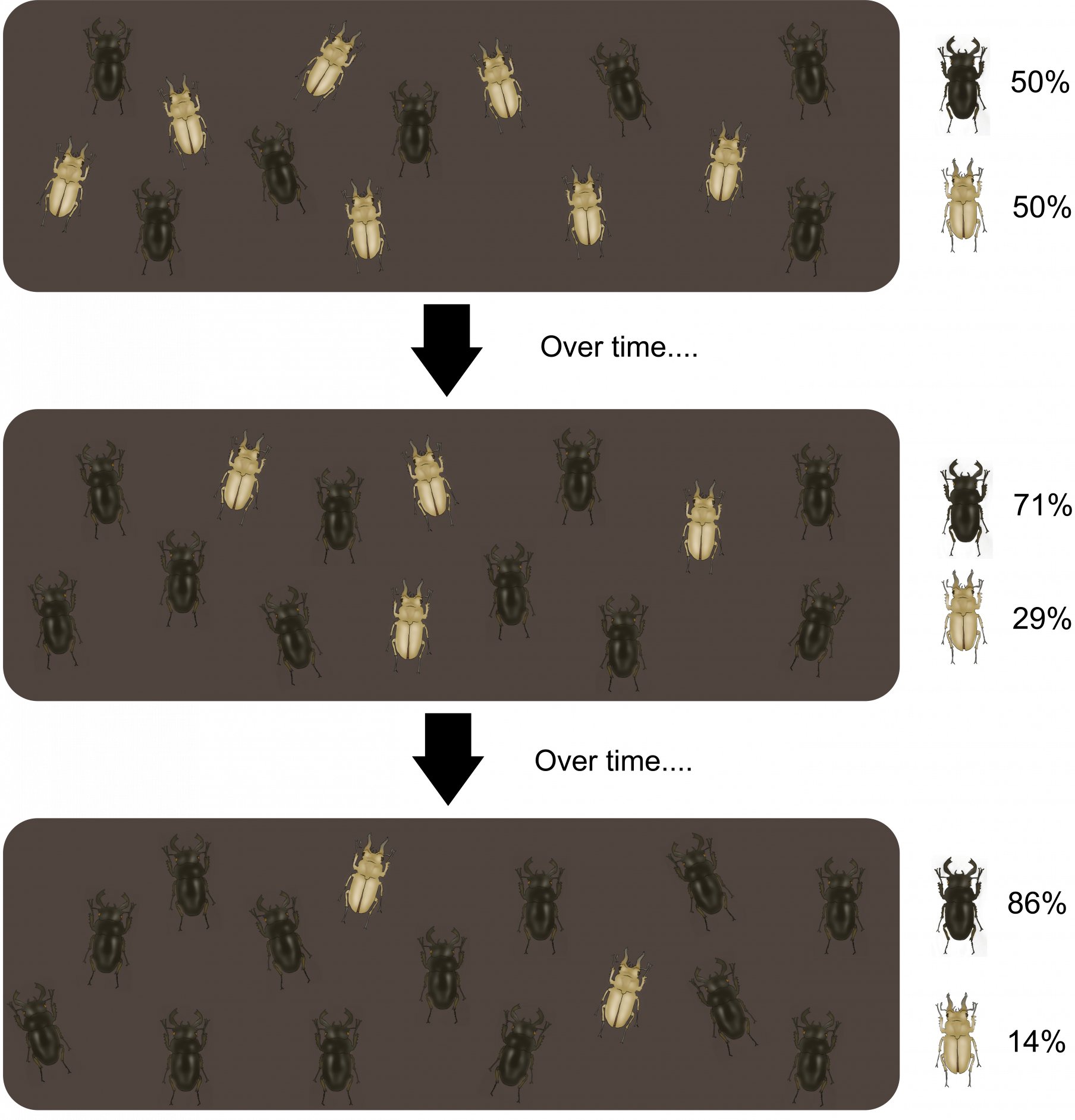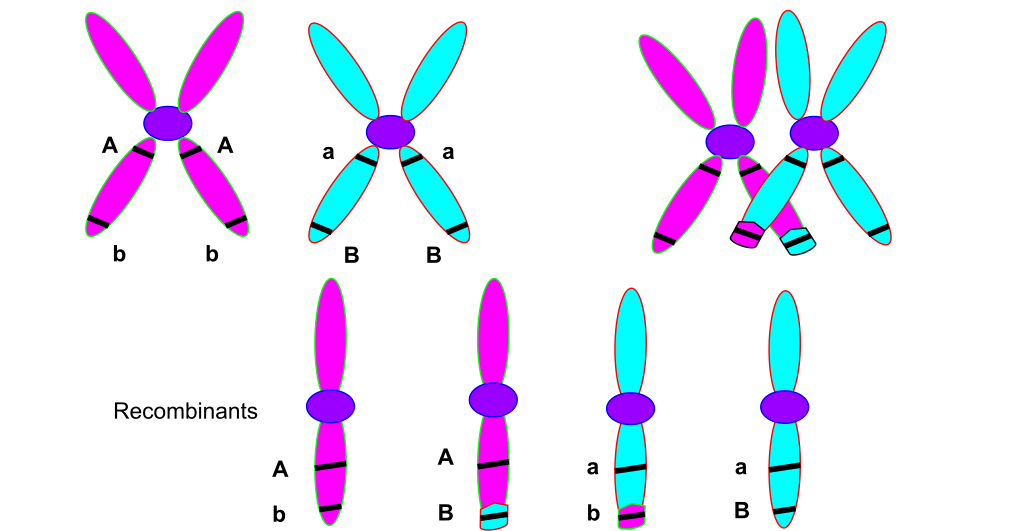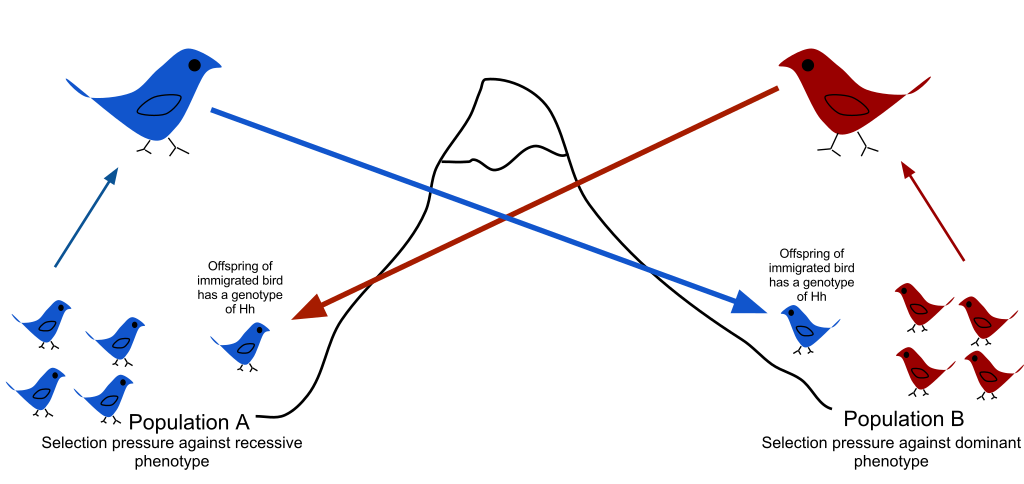IB Syllabus focus:
‘Evolution is cumulative, heritable change. Natural selection arises from variation, overproduction and competition, causing differential survival and reproduction; advantageous alleles increase in frequency across generations.’
Evolution and natural selection form the foundation of biology, explaining how species adapt and change over time. These processes shape biodiversity, resilience, and ecosystem functioning.
Understanding Evolution
Evolution refers to cumulative, heritable change across generations. It explains how organisms gradually transform, diversify, and adapt to environments over long timescales.
Evolution: The cumulative, heritable change in populations of organisms across successive generations, leading to altered genetic composition and potential emergence of new traits or species.
Evolution depends on the passing of heritable traits from one generation to the next. Random genetic changes (mutations, recombination) provide raw material for change, but environmental pressures determine which traits persist.
Natural Selection: The Driving Force
Natural selection is the key mechanism of evolutionary change. It explains why some traits spread while others disappear.
Natural Selection: The process by which individuals with advantageous heritable traits survive and reproduce at higher rates, increasing the frequency of those traits in the population.
Key Conditions of Natural Selection
Natural selection requires specific conditions:
Variation: Individuals differ genetically and phenotypically within a population.
Overproduction: Populations produce more offspring than the environment can support.
Competition: Limited resources create struggle for survival.
Differential survival and reproduction: Those with advantageous traits (e.g., better camouflage, resistance to disease) are more likely to reproduce successfully.
Inheritance: Traits are passed to offspring, ensuring cumulative change.
Together, these conditions cause allele frequencies (the proportion of gene variants) to shift across generations, driving long-term evolution.

Three panels illustrate natural selection within a beetle population: across generations, the dark phenotype becomes more common due to higher survival and reproductive success. This directly demonstrates how selection changes trait—and thus allele—frequencies over time. The figure’s labels and layout are concise and appropriate for IB students. Source.
Variation: The Basis of Evolution
Variation is essential because it provides the raw material upon which selection acts. Without variation, natural selection cannot operate.
Sources of variation include:
Mutations: Random changes in DNA that may produce new traits.
Sexual reproduction: Mixing of alleles during meiosis and fertilisation increases genetic combinations.
Gene flow: Movement of individuals between populations introduces new alleles.
Allele: A variant form of a gene found at a specific location on a chromosome.
Populations with greater variation are more resilient, since they contain a wider range of potential adaptations.

Diagram of homologous chromosomes undergoing crossing-over during meiosis I, generating recombinant chromatids and increasing genetic variation available to selection. Labels illustrate how allele combinations change after the exchange. This figure aligns with the IB emphasis on sexual reproduction as a key source of heritable variation. Source.

A schematic of gene flow: an organism migrates from population A to population B and, through mating, introduces new alleles that change allele frequencies. Gene flow is a major mechanism generating heritable variation on which selection can act. The diagram is intentionally simplified to match IB scope. Source.
Overproduction and Competition
Most species produce more offspring than can survive. For example, plants release thousands of seeds, but only a small fraction grow into mature plants. This overproduction ensures competition for space, food, mates, and other resources. The resulting struggle drives natural selection, since only the best-adapted individuals survive and pass on traits.
Adaptations: Key Outcomes of Natural Selection
Adaptations are heritable traits that increase an organism’s likelihood of survival and reproduction in a specific environment.
Adaptation: A heritable characteristic that improves the chances of survival and reproduction in a particular environment.
Adaptations may be:
Structural: Physical features such as thick fur or sharp teeth.
Physiological: Internal processes, e.g., tolerance to drought or production of toxins.
Behavioural: Actions that enhance survival, such as migration or nocturnal activity.
Through time, populations accumulate adaptations that match their environment, demonstrating the cumulative nature of evolution.
Fitness and Differential Reproduction
The success of natural selection depends on fitness, a measure of reproductive success.
Fitness: The ability of an individual to survive, reproduce, and pass on genes to the next generation compared to others in the population.
Individuals with higher fitness leave more offspring. Over generations, advantageous alleles increase in frequency, reshaping the population’s genetic profile.
Evolutionary Change Across Generations
Evolution does not occur within individuals but across populations over many generations. Key patterns include:
Directional selection: Favouring one extreme trait, e.g., longer beaks.
Stabilising selection: Favouring average traits, e.g., human birth weight.
Disruptive selection: Favouring both extremes, reducing intermediate forms.
These processes continually shift populations, sometimes leading to new species when change is significant.
The Genetic Basis of Natural Selection
The mechanism of evolution is underpinned by allele frequency changes in a population’s gene pool.
Gene Pool: The total collection of alleles present within a population.
Over time, advantageous alleles become more common, while harmful ones decline. These shifts can be measured across generations to track evolutionary trends.
Environmental Influence on Evolution
Environmental pressures act as selective forces. Examples include:
Predation and disease
Climate change
Food availability
Human activities (pollution, habitat destruction)
When the environment shifts, traits once advantageous may become neutral or disadvantageous. Evolution is therefore a dynamic process responding to ecological conditions.
Importance of Evolution in Environmental Systems and Societies
Understanding evolution and natural selection is vital in Environmental Systems and Societies because:
It explains biodiversity and resilience.
It clarifies how populations adapt to disturbances.
It underpins conservation biology, showing why genetic variation is crucial for survival.
It highlights human impacts on evolutionary processes, such as antibiotic resistance or rapid adaptation in changing climates.
In summary, evolution is cumulative, heritable change, driven by natural selection through variation, overproduction, and competition, resulting in differential survival and reproduction that reshapes populations across generations.
FAQ
Heritable variation arises from genetic differences passed through DNA, such as mutations or recombination during meiosis. These traits influence survival and reproduction across generations.
Acquired traits, like muscle gain from exercise, are not encoded in genes and therefore cannot be inherited. Only heritable variation drives evolutionary change through natural selection.
Cumulative change emphasises that evolution is not a single shift but the accumulation of small genetic changes over many generations.
This gradual build-up allows populations to adapt to long-term environmental pressures. Without cumulative change, variation would remain temporary and not shape species over time.
In stable environments, competition may favour traits that maintain efficiency and conserve resources.
In changing environments, competition often shifts rapidly, favouring flexible or novel traits that help individuals cope with new challenges such as temperature fluctuations or altered food sources.
Recessive alleles may remain hidden in heterozygous individuals and only appear when two copies are present.
This allows potentially advantageous recessive traits to persist in a population even if they are rare. Under new conditions, such alleles may become beneficial and increase in frequency.
Selective agents are factors that influence which traits are advantageous. These include:
Predators selecting against poorly camouflaged individuals
Climate influencing tolerance traits (e.g., drought resistance)
Human activity creating pressures such as pollution or hunting
The type and strength of these agents determine how populations evolve in response.
Practice Questions
Question 1 (2 marks)
State two conditions necessary for natural selection to occur in a population.
Mark Scheme
Variation within the population (1)
Overproduction of offspring (1)
Competition for limited resources (1)
Inheritance of advantageous traits (1)
Differential survival and reproduction (1)
(Max 2 marks. Any two correct conditions receive credit.)
Question 2 (5 marks)
Explain how variation and overproduction contribute to natural selection, and outline the role of advantageous alleles in shaping future populations.
Mark Scheme
Variation provides differences in traits among individuals (1)
Overproduction leads to competition for resources (1)
Some individuals possess advantageous traits that increase survival/reproduction (1)
These traits are heritable and passed on to offspring (1)
Over generations, advantageous alleles increase in frequency in the population (1)
(Max 5 marks. Award 1 mark for each clearly explained point.)

